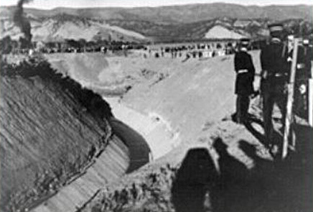If the title of this blog is too obscure for you then check out this you-tube video
https://www.youtube.com/watch?v=mCF_xzxhxME
Greetings fellow readers and followers of this blog
WELL - Birgit and I have lucked out with a camping spot that has not one but TWO bars of cell service - allowing us to do multiple blog posting. We have seen many wonderous things on this road trip, and we have learned a lot. One thing we have learned about are "National Historic Civil Engineering Landmarks"
Who knew that the American Society of Civil Engineers have an award system for FABULOUS FEATS of engineering! I just learned that the Alaska Highway is one of these feats. But on this trip we have visited not one but two sites that are National Historic Civil Engineering Landmarks.
The first site was at Mesa Verde, when we hiked out to one of the many archeological sites and found the Prehistoric Mesa Verde Water Resovours:
For over 500 years the people who lived at Mesa Verde maintained water reservoirs that held their drinking water. We had been hiking and I was thinking where on earth did they get there water from, and we can across this huge pond:
It was unbelievable. (no one could tell me what they did with their human waste.....)
Birgit and I marveled at the fact that Ancestral People could build something that would merit an award, and that a bunch of engineers had recognized this fact and given it a Historical Landmark designation.
The we arrived at the Black Canyon of the Gunnison and lo and behold - here was a second National Historic Landmark of Civil Engineering - the Gunnison Tunnel.
Well - we did NOT see the Gunnison Tunnel with our own eyes, but we learned about it. The tunnel is at the bottom of the canyon - and I don't think anyone can see it. The tunnel was the longest irrigation tunnel in America and it took years to build. Here are some facts for you and a photo that I have copied from the ASCE website:
- The project required construction of one of the steepest wagon roads imaginable to reach the work area. In some places, the grade was nearly 30 percent. Even with the road, heavy machinery had to be eased down to the construction site on skids and held back with block and tackle.
- Seeping water was common, but in December, 1906, tunnelers hit such a huge underground stream that jets shot 40 feet into the tunnel, knocking the drillers from their machines and halting work on the heading for six months.
- Hot-water seams and seepage heated the working area to the point where physical conditions were almost unbearable. A 400-foot ventilating shaft had to be constructed to keep workers alive.
 If you want to learn more about National Historic Civil Engineering Landmarks here is the link to the web page:
If you want to learn more about National Historic Civil Engineering Landmarks here is the link to the web page:- https://www.asce.org/about-civil-engineering/history-and-heritage/historic-landmarks
Comments
Post a Comment